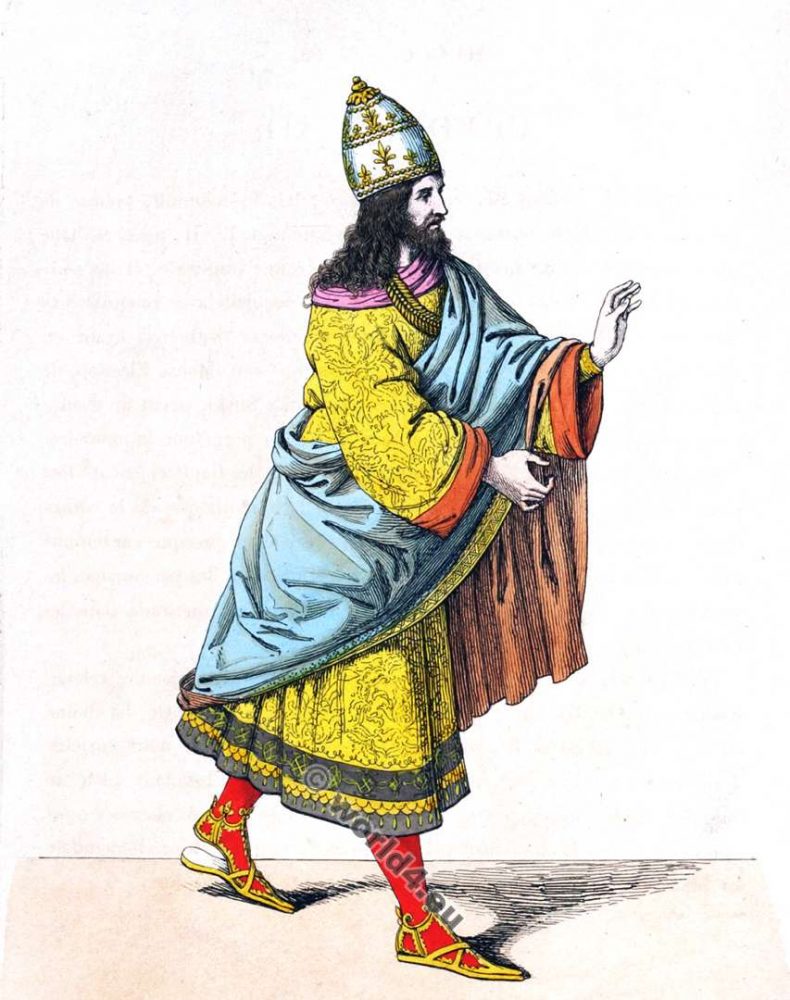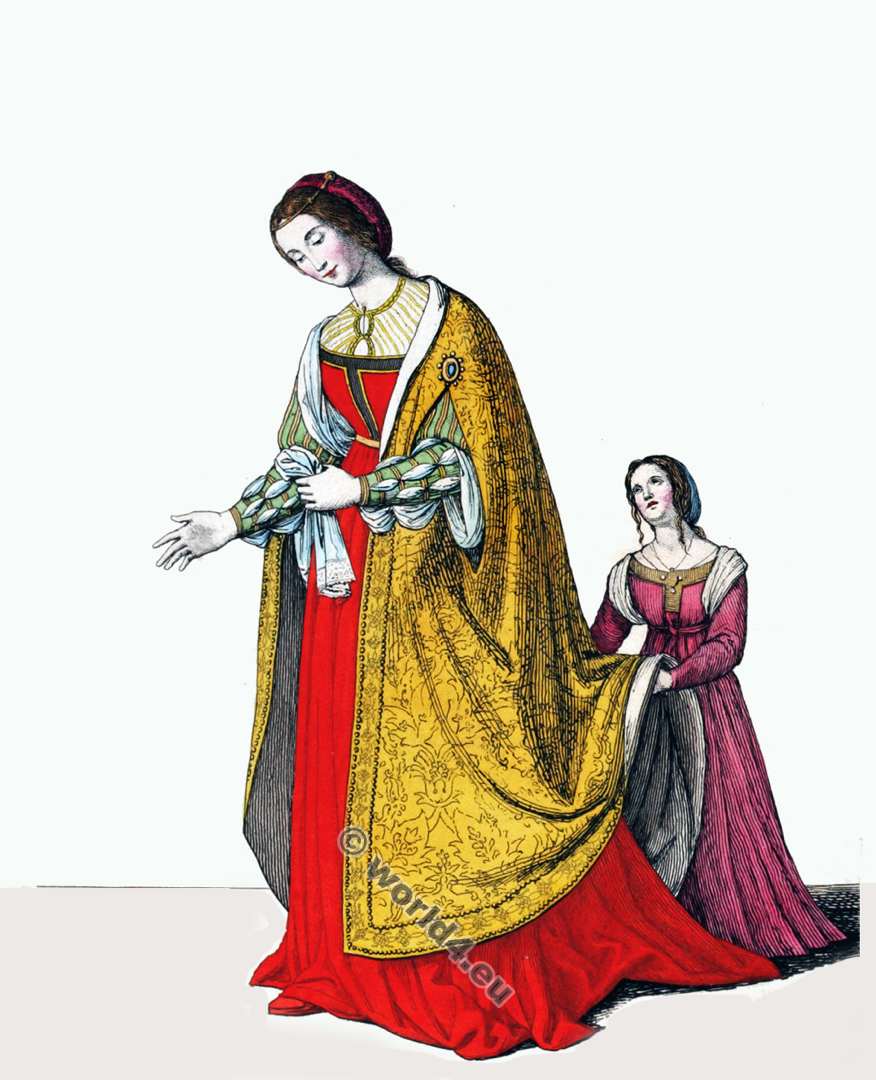
Friedrich III. 1415 -1493, from the house of Habsburg was from 1440 Roman-German king and from 1452 Emperor of the Holy Roman Empire. He was the penultimate Roman-German emperor who was crowned by the Pope, and the last, in which this was done in Rome. On March 16, Friedrich was crowned as the last Roman-German king to the Italian king and three days later in Rome by Pope Nicholas V as Emperor. Frederick’s reign was the longest of all the Holy Roman Emperor. Friedrich claimed astrology for important political decision-making. Probably for no other rulers of the Middle Ages had the astrology so much importance as for the Habsburger.
Frederick III. 1415 -1493. Emperor of the Holy Roman Empire. Costume History. Late Middle Ages, early Renaissance.
FRIEDERIC III, yielding to the advice of Aeneas Silvio Piccolomini, Bishop of Siena and later Pontiff under the name of Pius II, travelled to Italy to receive the imperial crown from Nicholas V. He was crowned in Rome on 15 March 1452. This prince was received with magnificence in all the cities he passed through, but Siena stood out, having had the advantage of bringing together within its walls the emperor and his wife Eleanor of Portugal. His stay in this city, home of Aeneas Silvio, seemed too glorious an event for the republic not to perpetuate its memory.
A few years later, the Pinturicchio, with the help of the still very young Raphael, was commissioned to paint the principal actions of Pius II in the cathedral library. This painter was almost a contemporary, so in his paintings he brought together portraits of the most illustrious figures of the period with that scrupulous accuracy in costume that gives his works such distinction.
Frédéric’s head is covered with a kind of bluish thiare with gold ornaments. The scarf he wears around his neck is purplish. The chain is gold. The habit is of gold brocade finished with a black band enriched with a light gold embroidery. The coat is a brocaded fabric, bluish in the light, changing to green in the shadows. The socks are red, as is the shoe, which is embellished with gold ornaments. The sandal is white where the foot rests, the rest is gold.
Source: Historical costumes of the thirteenth, fourteenth and fifteenth centuries, extracted from the most authentic monuments of painting and sculpture, drawn and engraved by Paul Mercuri, with a historical and descriptive text by Camille Bonnard. Author / Edit:. Bonnard, Camille. Place of Publication: Paris Year: 1845. Publisher: Goupil et Vibert. 1st French edition Paris: Treuttel et Würtz, 1829-1830.
Frédéric III. 1415 -1493
Empereur du Saint Empire romain germanique. Costume Histoire. Fin du Moyen Age, au début de la Renaissance.
FRÉDÉRIC III.
FRÉDÉRIC III, cédant aux conseils d’Énée Silvio Piccolomini, évêque de Sienne, et plus tard souverain pontife sous le nom de Pie II, passa en Italie pour y recevoir des mains de Nicolas V la couronne impériale. Il fut Couronnè à Rome le 15 mars 1452. Ce prince fut accueilli avec magnificence dans toutes les villes qu’il traversa; mais Sienne se distingua, ayant eu l’avantage de réunir dans ses murs l’empereur et son épouse Eléonore de Portugal. Son séjour clans cette ville, patrie d’Énée Silvio, parut un évènement trop glorieux à la république pour ne pas en perpétuer la mémoire.
Quelques années plus tard le Pinturicchio, aidé de Raphaël encore fort jeune, fut chargé de peindre dans la salle de la bibliothèque de la cathédrale les principales actions de Pie II. Ce peintre était presque contemporain, aussi a-t-il réuni dans ses tableaux les portraits des personnages les plus illustres de cette époque avec celte scrupuleuse exactitude dans les costumes qui donne tant de prix à ses ouvrages.
Frédéric a la tête couverte d’une espèce de thiare fond bleuâtre relevée d’ornemens d’or. L’écharpe qu’il porte autour du cou est violâtre. La chaîne est d’or. L’habit est de brocart d’or terminé par une bande noire enrichie d’une légère broderie d’or. Le manteau est d’une étoffe brochée, bleuâtre dans les clairs, changeant en vert dans les ombres. Les chausses sont rouges, ainsi que la chaussure qui est relevée d’ornemens en or. La sandale est blanche dans la partie où repose le pied, le reste en est doré.
Source: Costumes historiques des XIIIe, XIVe et XVe siècles, extraits des monuments les plus authentiques de peinture et de sculpture, dessinés et gravés par Paul Mercuri, avec un texte historique et descriptif par Camille Bonnard. Auteur / Edit:. Bonnard, Camille. Lieu de publication: Paris Année: 1845. Editeur: Goupil et Vibert. 1ère édition francaise Paris: Treuttel et Würtz, 1829-1830.
Related
Discover more from World4 Costume Culture History
Subscribe to get the latest posts sent to your email.






